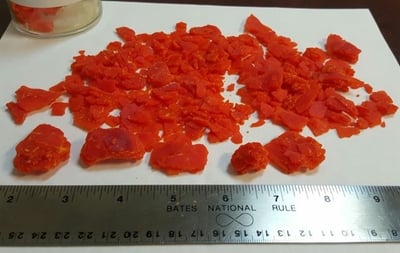Dealing with Lumps and Clumps in Solids
 In a previous blog post, we discussed some of the factors that cause solids to become cohesive and agglomerate while stored in common shipping containers such as small bags (typically < 25 Kg), drums and FIBCs (bulk bags). This post will expand on understanding the mechanisms and forces that cause agglomerations to form, discuss negative impacts on production and profits, and present various means of preventing them from forming, and eliminating them if they do.
In a previous blog post, we discussed some of the factors that cause solids to become cohesive and agglomerate while stored in common shipping containers such as small bags (typically < 25 Kg), drums and FIBCs (bulk bags). This post will expand on understanding the mechanisms and forces that cause agglomerations to form, discuss negative impacts on production and profits, and present various means of preventing them from forming, and eliminating them if they do.
Agglomeration Attribution
Listed below are five basic types of physical binding forces which can occur between solid particles and result in agglomerate formation.
- Solid bridges (e.g., partial melting, sintering & chemical reactions)
- Adhesive or cohesive forces (e.g., binders and adsorption layers)
- Surface tension (e.g., liquid bridges and capillary forces)
- Attractive forces (e.g., molecular and electrostatic)
- Interlocking bonds
Following are brief explanations of how these mechanisms can contribute to agglomerate formation during various processes involving solids, including mixing, size reduction and conveying.
Mixing
During mixing or blending of dry or wet solids, the smallest particles will often agglomerate together due to:
- bonding forces between molecules of individual particles
- electrostatic attraction when particles become oppositely charged due to friction between one another or equipment surfaces
- capillary forces where moisture within the particles forms a liquid bridge and binds them together
These type of agglomerates can be prevented or eliminated by selecting a mixer that can impart sufficient motion within the mass of solids such that sufficient shear forces are created to overcome the binding force. In some cases, the mixer may need to be fitted with ancillary components such as choppers or knife blades to create the necessary motion and shear force.
Agglomerates can also form when introducing solids into a liquid. In those instances, it is important to select an agitator design capable of imparting shear forces within the liquid that are high enough to prevent particle binding. Also, adding surfactant or dispersion agents to the mixture can also help prevent agglomerations from forming, but this may not be possible due to the specific chemistry involved.
Size Reduction
This can be achieved by various methods, but this article will only address one of the most common processes which is known as “compression grinding”. Compression grinding occurs when particles are squeezed between mechanical surfaces such as balls in tumblers or cylinders in rolling mills. However, this process has a limitation due to the fact that at some minimum size, the particles will begin to bind together due to either adherence or agglomerate formation.
Adherence occurs when small, fine particles begin to stick to mechanical surfaces inside mills or other size reduction equipment. This coating of fine particles will then allow other, often larger particles to adhere on top of the initial material deposits. As the layers of solids build, the compressing force on the remaining free material is “cushioned” due to the layers of deposits. This can reduce the efficiency of the milling operation and lengthen the time required to achieve the desired level of final particle size. Adherence can also be caused by electrostatic attraction between the moving particles and the mill surfaces. Finally, adherence can occasionally be the result of heat generated during the milling operation, which softens or melts some solid particles. This can result in strong molecular binding forces that cause the particles to stick together and adhere to the mill’s surfaces.
Agglomerate formation occurs when the compression force that is exerted on the solid particles by the mill’s mechanical surfaces causes particles to stick together. At some point, the size reduction achieved by the mill will be off-set by this agglomerate forming effect and a phenomenon known as “grinding limit” will result. At this point, no further particle size reduction can be achieved, because agglomerate formation in the solids is off-set by, and in equilibrium with the size reduction process that continues to occur. However, while further particle size reduction might cease to occur, a phenomenon known as mechanical activation can happen. This is due to an increase in the particles’ surface area that results when they are repeatedly broken up following agglomerate formation as described above.
Prevention of adherence can often be achieved by simply grounding a mill or polishing / coating its internal surfaces. Prevention of agglomerate formation is frequently achieved by use of grinding aids which bond with the small particles thus preventing them from adhering to mill surfaces or recombining with one another.
Conveying
Formation of agglomerates and material build-up on surfaces can occur during both pneumatic and mechanical conveying. This happens most frequently when the conveyed material is a very fine powder. Agglomerates form most frequently during mechanical conveying, especially in vibrating or inclined components, but material build-up on surfaces is more common in pneumatic conveying systems. In both cases, these problems typically occur due to molecular or electrostatic binding forces, but in some cases they can be caused by moisture related issues such as liquid bridges or capillary attraction. However, if a conveying system imparts heat to the powder due to friction from moving parts, agglomerates can form when particles partially melt and become sintered together.
Preventing formation of agglomerates in mechanical conveyors (especially in vibrating components), can be difficult. For this reason, it’s often best to select a pneumatic (or other type) of system to convey extremely fine powders. Some preventative measures that might help include enclosing the mechanical system to keep humidity out or coating internal surfaces to help prevent material build-up.
Fortunately, there are many ways to prevent particle agglomeration in pneumatic conveying systems, including the use of smooth-walled conveying lines (such as polished metal tubing), selecting static dissipating or conductive materials, and maintaining relatively high transport velocities to prevent material adhesion to surfaces.
In closing, unwanted agglomerates can form in many bulk solids handling operations, including those already discussed here or simply storing them in silos or bags. Some knowledge and understanding of the various forces involved can help in preventing their formation in the first place, and eliminating them as quickly as possible when they do. For more information on this subject and real-life examples of agglomeration issues and solutions, watch our on-demand Webinar on Lumps & Clumps in Solids: Their Causes and Cures.
